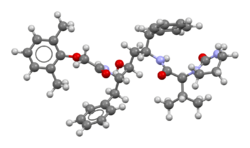Chemistry:Lopinavir
 | |
 | |
| Clinical data | |
|---|---|
| Other names | ABT-378 |
| AHFS/Drugs.com | International Drug Names |
| MedlinePlus | a602015 |
| License data | |
| Routes of administration | By mouth |
| ATC code | |
| Legal status | |
| Legal status | |
| Pharmacokinetic data | |
| Bioavailability | Unknown |
| Protein binding | 98-99% |
| Metabolism | Liver |
| Elimination half-life | 5 to 6 hours |
| Excretion | Mostly fecal |
| Identifiers | |
| |
| CAS Number | |
| PubChem CID | |
| DrugBank | |
| ChemSpider | |
| UNII | |
| KEGG | |
| ChEMBL | |
| Chemical and physical data | |
| Formula | C37H48N4O5 |
| Molar mass | 628.814 g·mol−1 |
| 3D model (JSmol) | |
| |
| |
| (verify) | |
Lopinavir is an antiretroviral of the protease inhibitor class. It is used against HIV infections as a fixed-dose combination with another protease inhibitor, ritonavir (lopinavir/ritonavir).[1]
It was patented in 1995 and approved for medical use in 2000.[2]
Side effects
Side effects, interactions, and contraindications have only been evaluated in the drug combination lopinavir/ritonavir.[citation needed]
Pharmacology
Lopinavir is highly bound to plasma proteins (98–99%).[3]
Reports are contradictory regarding lopinavir penetration into the cerebrospinal fluid (CSF). Anecdotal reports state that lopinavir cannot be detected in the CSF; however, a study of paired CSF-plasma samples from 26 patients receiving lopinavir/ritonavir found lopinavir CSF levels above the IC50 in 77% of samples.[4]
Research
A 2014 study indicates that lopinavir is effective against the human papilloma virus (HPV). The study used the equivalent of one tablet twice a day applied topically to the cervices of women with high-grade and low-grade precancerous conditions. After three months of treatment, 82.6% of the women who had high-grade disease had normal cervical conditions, confirmed by smears and biopsies.[5] Lopinavir has been shown to impair protein synthesis via AMP-activated protein kinase (AMPK) and eEF2 kinase (eEF2K) activation, a mechanism that is similar to the antiviral effect of protein phosphatase 1 inhibitors.[6][7]
Lopinavir was found to inhibit MERS-CoV replication in the low-micromolar range in cell cultures.[8] In 2020, lopinavir/ritonavir was found not to work in severe COVID-19. In this trial the medication was started typically around 13 days after the start of symptoms.[9]
References
- ↑ "FDA Approved Drug Products: Kaletra". http://www.accessdata.fda.gov/scripts/cder/drugsatfda/index.cfm?fuseaction=Search.Overview&DrugName=KALETRA&CFID=26857748&CFTOKEN=5e0033c7f3434629-F5F0F717-D23E-F790-EB3406425F2FD57C.
- ↑ Analogue-based Drug Discovery. John Wiley & Sons. 2006. p. 510. ISBN 9783527607495. https://books.google.com/books?id=FjKfqkaKkAAC&pg=PA510.
- ↑ Kaletra (lopinavir/ritonavir) capsules; (lopinavir/ritonavir) oral solution. Prescribing information. April 2009
- ↑ "Lopinavir concentrations in cerebrospinal fluid exceed the 50% inhibitory concentration for HIV". AIDS 19 (9): 949–52. June 2005. doi:10.1097/01.aids.0000171409.38490.48. PMID 15905676.
- ↑ HIV drug used to reverse effects of virus that causes cervical cancer University of Manchester, 17 February 2014.
- ↑ "Protein phosphatase 1 regulates Human Cytomegalovirus protein translation by restraining AMPK signaling". Frontiers in Microbiology 12: 698603. 2021. doi:10.3389/fmicb.2021.698603. ISSN 1664-302X. PMID 34335531.
- ↑ "1E7-03, a low MW compound targeting host protein phosphatase-1, inhibits HIV-1 transcription". British Journal of Pharmacology 171 (22): 5059–75. November 2014. doi:10.1111/bph.12863. PMID 25073485.
- ↑ "Screening of an FDA-approved compound library identifies four small-molecule inhibitors of Middle East respiratory syndrome coronavirus replication in cell culture". Antimicrobial Agents and Chemotherapy 58 (8): 4875–84. August 2014. doi:10.1128/AAC.03011-14. PMID 24841269.
- ↑ "A Trial of Lopinavir-Ritonavir in Adults Hospitalized with Severe Covid-19". The New England Journal of Medicine 382 (19): 1787–1799. May 2020. doi:10.1056/NEJMoa2001282. PMID 32187464.
External links
- "Lopinavir". Drug Information Portal. U.S. National Library of Medicine. https://druginfo.nlm.nih.gov/drugportal/name/lopinavir.
 |
